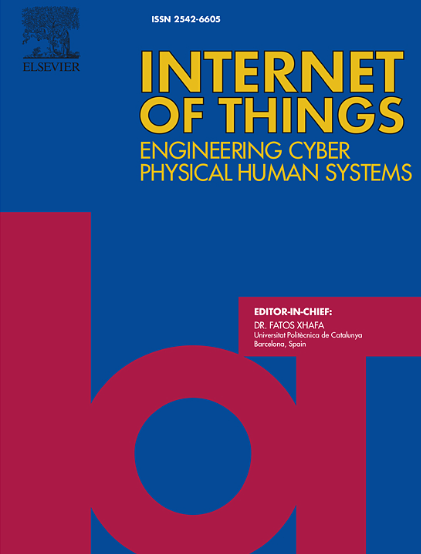Bioinspired small language models in edge systems for bee colony monitoring and control
IF 7.6
3区 计算机科学
Q1 COMPUTER SCIENCE, INFORMATION SYSTEMS
引用次数: 0
Abstract
This paper proposes a hybrid IoT architecture based on Generative Artificial Intelligence (Gen-AIoT) for the intelligent monitoring and control of beehives, designed with processing capabilities both at the edge and in the cloud, thus adapting to environments with or without internet connectivity. Through an IoT sensor network, the system collects critical data on environmental parameters and hive conditions, such as temperature, humidity, wind speed, and hive weight, processing them locally at the edge or centrally in the cloud. The architecture incorporates a recommendation system that uses a small language model (SLM) to generate real-time alerts based on data provided by the IoT sensors. This system implements two distinct SLM models, Phi-3.5 and Tinyllama, enabling hardware performance measurement and optimizing efficiency for edge processing. To establish optimal environmental ranges, the recommendation system uses bio-inspired algorithms, such as ant colony optimization, genetic algorithms, and bee swarm algorithms. Additionally, LSTM neural networks are included to predict honey production and plan hive placement based on climate and weight projections, allowing for precise and personalized adjustments. This dual processing capability (edge and cloud) reduces the need for human intervention, optimizes hive inspection times, and minimizes false positives in monitoring, making it especially beneficial for large-scale beekeeping, where weekly inspection times can exceed 50 h. With this architecture, inspection time is reduced by 80%, significantly improving efficiency in hive management and promoting sustainable practices for bee conservation through intelligent agriculture.
边缘系统中用于蜂群监测和控制的生物启发小语言模型
本文提出了一种基于生成式人工智能(Gen-AIoT)的混合物联网架构,用于蜂窝的智能监测和控制,设计具有边缘和云处理能力,从而适应有或没有互联网连接的环境。系统通过物联网传感器网络收集环境参数和蜂箱状况的关键数据,如温度、湿度、风速、蜂箱重量等,并在边缘本地或云端集中处理。该架构包含一个推荐系统,该系统使用小型语言模型(SLM)根据物联网传感器提供的数据生成实时警报。该系统实现了两种不同的SLM模型,Phi-3.5和Tinyllama,使硬件性能测量和优化边缘处理效率。为了建立最优的环境范围,推荐系统使用了仿生算法,如蚁群优化、遗传算法和蜂群算法。此外,LSTM神经网络被用于预测蜂蜜产量,并根据气候和重量预测计划蜂巢的位置,允许精确和个性化的调整。这种双重处理能力(边缘和云)减少了对人工干预的需求,优化了蜂箱检查时间,并最大限度地减少了监测中的误报,使其特别有利于大规模养蜂,每周检查时间可以超过50小时。通过这种架构,检查时间减少了80%,显著提高了蜂箱管理效率,并通过智能农业促进了蜜蜂保护的可持续实践。
本文章由计算机程序翻译,如有差异,请以英文原文为准。
求助全文
约1分钟内获得全文
求助全文
来源期刊

Internet of Things
Multiple-
CiteScore
3.60
自引率
5.10%
发文量
115
审稿时长
37 days
期刊介绍:
Internet of Things; Engineering Cyber Physical Human Systems is a comprehensive journal encouraging cross collaboration between researchers, engineers and practitioners in the field of IoT & Cyber Physical Human Systems. The journal offers a unique platform to exchange scientific information on the entire breadth of technology, science, and societal applications of the IoT.
The journal will place a high priority on timely publication, and provide a home for high quality.
Furthermore, IOT is interested in publishing topical Special Issues on any aspect of IOT.
 求助内容:
求助内容: 应助结果提醒方式:
应助结果提醒方式:


